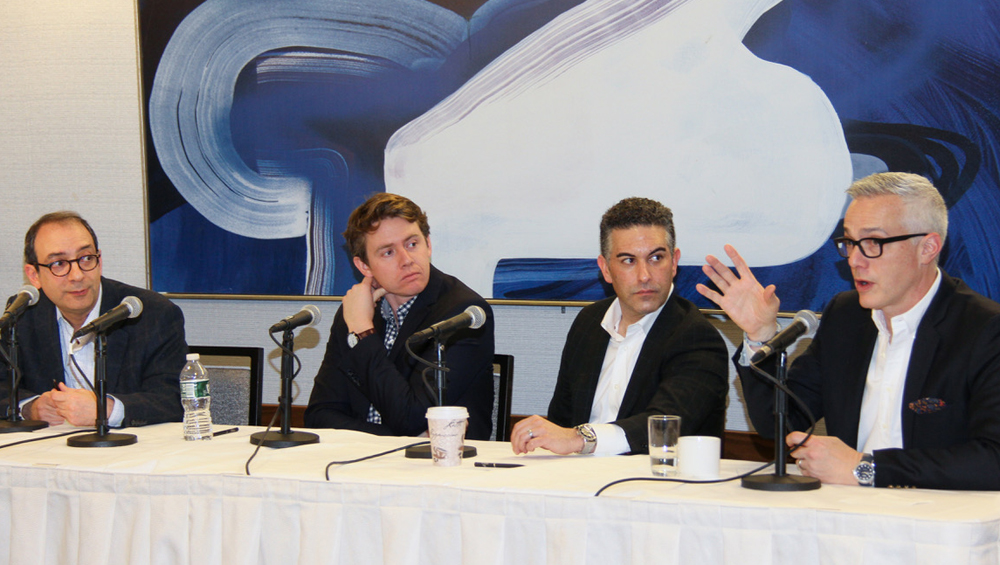
NewsTECHForum | News Storytelling A Whole New Ballgame

NEW YORK — In September, NBCU launched its digital news brand LX, as part of the company’s efforts to lure in millennial and Gen Z viewers. It was a step into deeper tech waters for NBCU, signaling a mindfulness of what the future of broadcasting will probably look like. But the past few months of producing content for the platform has proven that many tried-and-true tactics must continue to be used.
“I think we definitely lean on our pictures to really help drive the story,” said Matt Goldberg, VP of content for NBCU LX, during a panel discussion at TVNewsCheck’s NewsTECHForum on Tuesday. Describing the approach to their aesthetics as “cinematic,” Goldberg said the platform’s producers place “a premium on pictures.”
“We’re in that business,” he added pointedly.
Compelling images remain vital in delivering stories designed for broadcast. Still, the digital age has changed viewer expectations in a number of ways.
Perhaps with attention spans relatively deteriorating, members across the panel, “New Frontiers in News Storytelling,” moderated by TVNewsCheck Editor Michael Depp, said their digital-first stories have to draw viewers in immediately.
“Everything is in the first five seconds; you can win or lose in those first five seconds,” said Michael Koenigs, EP of Localish, a digital storytelling series produced for the Disney ABC Television Group. “Creating basically a thumbnail, or a wildly beautiful shot to grab people so they don’t keep scrolling [is] the No. 1 thing.”
Koenigs said he’s also given his reporters the freedom to take stylistic risks and shoot their images in “odd ways,” which could help the cause. His editors also stack many of their best images in the first 30 seconds across introductory elements of the longer narrative to get people to stick around.
“If you can get them to a minute you can hit the ad time on Facebook,” Koenigs said. “YouTube now wants to maximize those watch times” as well, he added.
Consistency is still key, too.
David Schechter, senior reporter, host and co-producer of Verify Road Trip, a storytelling series from Tegna-owned WFAA in Dallas, said that he’s committed to producing one story in full each week, so viewers can anticipate its arrival. Some of his tales demand a longform framework, like the recent 10-plus-minute documentary that took him and a climate change skeptic to Alaska.
Of course, the longer the film, the longer it takes to make. So, every other week, Schechter and his co-producer bang out a short spot of about two minutes in length, perhaps extra-appealing to the contemporary viewer.
Schechter also enjoys crucial creative freedom.
“Nobody really manages us through that process until we kind of get to more of an editorial crossroads,” he said. “It’s very hands off and I think that’s allowed us to put our stamp on it without having to be subject to a lot of rules.”
After watching Schechter’s piece about the climate change skeptic, Stephane Guez, co-founder and CTO of Dalet, a digital broadcasting platform-building company that employs AI technology to automate many important tasks, called it “a really compelling way of telling stories.” But he quickly added that the company behind it still has to ask, “How do we make that a sustainable business?
“It takes a lot of time to produce these pieces and you would want to make sure that it goes in front of all sorts of audiences,” Guez said.
No matter the length or production value of a story, to generate revenue production companies need eyes on it, which in and of itself is a challenge.
“Today, most of the money still comes from linear television; you would want to transform that model [in the digital space],” Guez said. “Somehow, because consumers have so much choice, you have to be in that business of promoting your work as well.”
The panel members appear up to the task.
During the Q&A portion of the discussion, an audience member asked if what they’re doing in digital is working to draw in younger viewers.
Koenigs said of Localish, “About 70% of our audience is under the age of 44, and we’ve generated over 200 million views.” He credited the company’s outreach on social media as a deciding factor.
If more organizations turn to the scroll of social media for views, the industry could continue on its path toward ultra-short stories becoming the status quo, he said.
“I think some of the most creative storytellers of tomorrow are those that can solve how you can make something interesting in 15 seconds,” Koenigs said, citing TikTok users as examples. “If you can solve the super-small storytelling, you’re going to be able to learn very well how to build longer.”
Watch the full video of the session here.
































Comments (0)